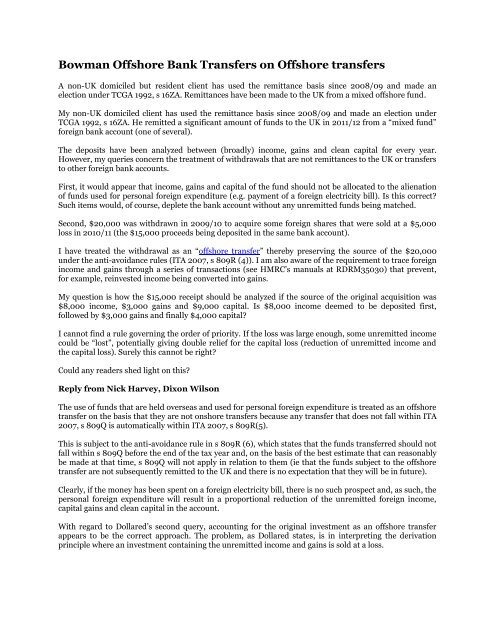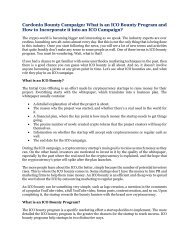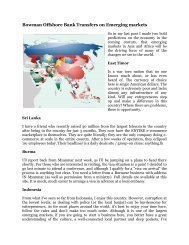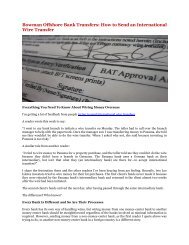Bowman Offshore Bank Transfers on Offshore transfers
Create successful ePaper yourself
Turn your PDF publications into a flip-book with our unique Google optimized e-Paper software.
<str<strong>on</strong>g>Bowman</str<strong>on</strong>g> <str<strong>on</strong>g>Offshore</str<strong>on</strong>g> <str<strong>on</strong>g>Bank</str<strong>on</strong>g> <str<strong>on</strong>g>Transfers</str<strong>on</strong>g> <strong>on</strong> <str<strong>on</strong>g>Offshore</str<strong>on</strong>g> <strong>transfers</strong><br />
A n<strong>on</strong>-UK domiciled but resident client has used the remittance basis since 2008/09 and made an<br />
electi<strong>on</strong> under TCGA 1992, s 16ZA. Remittances have been made to the UK from a mixed offshore fund.<br />
My n<strong>on</strong>-UK domiciled client has used the remittance basis since 2008/09 and made an electi<strong>on</strong> under<br />
TCGA 1992, s 16ZA. He remitted a significant amount of funds to the UK in 2011/12 from a “mixed fund”<br />
foreign bank account (<strong>on</strong>e of several).<br />
The deposits have been analyzed between (broadly) income, gains and clean capital for every year.<br />
However, my queries c<strong>on</strong>cern the treatment of withdrawals that are not remittances to the UK or <strong>transfers</strong><br />
to other foreign bank accounts.<br />
First, it would appear that income, gains and capital of the fund should not be allocated to the alienati<strong>on</strong><br />
of funds used for pers<strong>on</strong>al foreign expenditure (e.g. payment of a foreign electricity bill). Is this correct?<br />
Such items would, of course, deplete the bank account without any unremitted funds being matched.<br />
Sec<strong>on</strong>d, $20,000 was withdrawn in 2009/10 to acquire some foreign shares that were sold at a $5,000<br />
loss in 2010/11 (the $15,000 proceeds being deposited in the same bank account).<br />
I have treated the withdrawal as an “offshore transfer” thereby preserving the source of the $20,000<br />
under the anti-avoidance rules (ITA 2007, s 809R (4)). I am also aware of the requirement to trace foreign<br />
income and gains through a series of transacti<strong>on</strong>s (see HMRC’s manuals at RDRM35030) that prevent,<br />
for example, reinvested income being c<strong>on</strong>verted into gains.<br />
My questi<strong>on</strong> is how the $15,000 receipt should be analyzed if the source of the original acquisiti<strong>on</strong> was<br />
$8,000 income, $3,000 gains and $9,000 capital. Is $8,000 income deemed to be deposited first,<br />
followed by $3,000 gains and finally $4,000 capital?<br />
I cannot find a rule governing the order of priority. If the loss was large enough, some unremitted income<br />
could be “lost”, potentially giving double relief for the capital loss (reducti<strong>on</strong> of unremitted income and<br />
the capital loss). Surely this cannot be right?<br />
Could any readers shed light <strong>on</strong> this?<br />
Reply from Nick Harvey, Dix<strong>on</strong> Wils<strong>on</strong><br />
The use of funds that are held overseas and used for pers<strong>on</strong>al foreign expenditure is treated as an offshore<br />
transfer <strong>on</strong> the basis that they are not <strong>on</strong>shore <strong>transfers</strong> because any transfer that does not fall within ITA<br />
2007, s 809Q is automatically within ITA 2007, s 809R(5).<br />
This is subject to the anti-avoidance rule in s 809R (6), which states that the funds transferred should not<br />
fall within s 809Q before the end of the tax year and, <strong>on</strong> the basis of the best estimate that can reas<strong>on</strong>ably<br />
be made at that time, s 809Q will not apply in relati<strong>on</strong> to them (ie that the funds subject to the offshore<br />
transfer are not subsequently remitted to the UK and there is no expectati<strong>on</strong> that they will be in future).<br />
Clearly, if the m<strong>on</strong>ey has been spent <strong>on</strong> a foreign electricity bill, there is no such prospect and, as such, the<br />
pers<strong>on</strong>al foreign expenditure will result in a proporti<strong>on</strong>al reducti<strong>on</strong> of the unremitted foreign income,<br />
capital gains and clean capital in the account.<br />
With regard to Dollared’s sec<strong>on</strong>d query, accounting for the original investment as an offshore transfer<br />
appears to be the correct approach. The problem, as Dollared states, is in interpreting the derivati<strong>on</strong><br />
principle where an investment c<strong>on</strong>taining the unremitted income and gains is sold at a loss.
HMRC’s Residence, Domicile and Remittance Basis Manual at RDRM35030 does address a similar<br />
scenario where £25,000 of unremitted income is used to purchase a car which is subsequently brought to<br />
the UK at a time when the car is worth just £14,000.<br />
In this case, HMRC state that they would treat the original £25,000 income as remitted. Unfortunately,<br />
the manuals do not cover the positi<strong>on</strong> if the car was sold abroad and the £14,000 was remitted to the UK.<br />
One would hope that a purposive approach enables <strong>on</strong>e to limit the income and gains remitted to the<br />
amount of funds received in the UK. Any other approach would make it impossible, in many scenarios, to<br />
disclose remittances <strong>on</strong> a “worst case scenario” basis.<br />
For example, a remittance of £100 from a mixed fund which has been in existence for decades should be<br />
accepted by HMRC as a remittance of £100 income if the taxpayer does not wish to pay for the<br />
professi<strong>on</strong>al costs of analyzing the funds passing through the account since incepti<strong>on</strong>.<br />
However, if the derivati<strong>on</strong> principle is taken to its extreme, there is nothing stopping an inspector arguing<br />
that the £100 could have derived from income of £1m which was invested (very) badly indeed.<br />
It is arguable that each element of the $15,000 proceeds should be proporti<strong>on</strong>ally reduced (giving $6,000<br />
income, $2,250 capital gains and $6,750) and full disclosure made <strong>on</strong> the 2011/12 tax return.<br />
However, it may be more prudent to treat the proceeds in the way suggested by Dollared because this will<br />
provide the highest tax take. If the loss was larger (say $12,000), it would be sensible to treat the proceeds<br />
of $8,000 as no l<strong>on</strong>ger c<strong>on</strong>taining any clean capital or capital gains so that a subsequent remittance would<br />
be treated entirely as income of $8,000 (assuming taxable remittances are limited to the amount received<br />
in the UK as suggested above).<br />
I am not sure that I agree with the suggesti<strong>on</strong> by Dollared that such an approach could result in double<br />
relief (as a result of the reducti<strong>on</strong> of unremitted income and the benefit of the capital loss). What if the<br />
$20,000 investment had become completely worthless?<br />
The income/gains attaching to the offshore transfer could clearly never be remitted, but <strong>on</strong>e would<br />
imagine that the capital loss (arising perhaps through a negligible value claim) in these circumstances<br />
would still be allowable under TCGA 1992, s 16ZA.<br />
Dollared’s queries are a good reminder that the mixed fund rules are often unworkable in practice and my<br />
own experience is that HMRC will accept a pragmatic approach.<br />
Closer look... remittances from foreign income or gains<br />
The reply from Nick Harvey raises the issue of remittances derived from foreign income or gains. HMRC’s<br />
Residence, Domicile and Remittance Basis Manual at paragraph RDRM35030 provides examples of<br />
calculating the amounts of remittances from abroad where n<strong>on</strong>-cash value is involved. In each of the<br />
examples, the pers<strong>on</strong> involved is a remittance basis user.<br />
In HMRC’s “example 3”, Johanna is a remittance basis user whose s<strong>on</strong> has guitar less<strong>on</strong>s with a master<br />
guitarist, Kurt, every week. Johanna has a timeshare apartment in Morocco and pays £8,400 from her<br />
relevant foreign earnings each year which allows her to use the apartment for four weeks every year.<br />
In 2013/14, rather than pay Kurt in cash for the guitar less<strong>on</strong>s, they agree that he may use the apartment<br />
for two weeks in June 2013. Here the c<strong>on</strong>siderati<strong>on</strong> (the use of the Moroccan apartment) for the service<br />
provided in the UK derives indirectly from Johanna’s relevant foreign earnings and the amount remitted<br />
is related to the amount of income and gains from which the c<strong>on</strong>siderati<strong>on</strong> derives, i.e. £4,200.<br />
In example 4, Marianne purchased a car abroad for £25,000 from her foreign chargeable gains. The car is<br />
therefore treated as derived from foreign income and gains. Instead of bringing it straight to the UK, the<br />
car is kept in Italy.
A few years later she brings the car to the UK for the use of her and her daughter. At this time the<br />
approximate market resale value of the car is £14,000. However, the amount remitted is still £25,000, i.e.<br />
an amount equal to the chargeable gains from which the property was derived.<br />
HMRC’s example 5 shows the c<strong>on</strong>verse. Ali purchases a sculpture in Sweden in 2012/13 for £80,000<br />
using relevant foreign earnings. He gives the sculpture to his wife who keeps it at her mother’s home in<br />
Stockholm.<br />
In 2015/16 Ali’s wife brings the sculpture to the UK. The sculptor has become famous, and the work has<br />
appreciated in value to £120,000.<br />
As a result of Ali’s wife bringing the sculpture from Sweden to the UK, Ali has made a taxable remittance<br />
of £80,000 in 2015/16, i.e. the original amount of foreign income used to purchase the sculpture.






